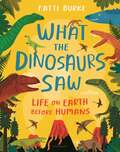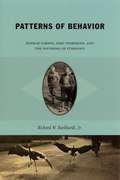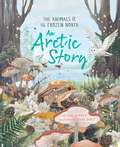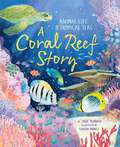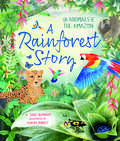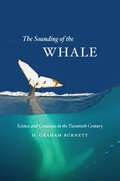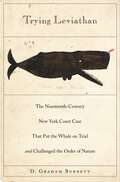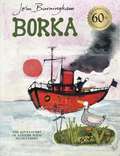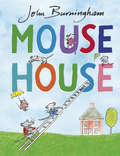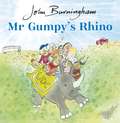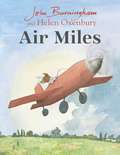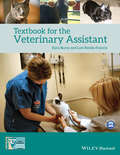- Table View
- List View
Pocket Reference to Alzheimer's Disease Management
by Anna Burke Geri R Hall Roy Yaari Adam Fleisher Jan Dougherty Jeffrey Young Helle Brand Pierre TariotThis Pocket Reference offer a multifaceted guide on various aspects of Alzheimer’s disease. This thorough review discusses the challenges of diagnosis, different stages of the disease, testing, and current treatment methods, including pharmacological and nonpharmacological management of cognitive decline and symptoms due to Alzheimer’s disease. The book also has specific chapters on care issues for patients with Alzheimer’s disease, which describes what clinician's and caregivers should expect and how to manage the disease at its various stages. Additionally, the book provides helpful guides, tables, and tips for clinicians and caregivers to help care for the patient and the caregiver themselves.
What the Dinosaurs Saw: Life on Earth Before Humans
by Fatti BurkeWith amazing facts and awe-inspiring illustrations, What the Dinosaurs Saw is a vibrant depiction of the earliest days of our universe and life on Earth.Our whole universe began as a tiny dot, filled with so much hot, dense energy that it burst. This event was the Big Bang, and from the remnants of that explosion, our whole universe was born. From those earliest beginnings 3.5 billion years ago to the mighty dinosaurs who roamed Earth 250 million years ago, this is the story of how life adapted, evolved, and survived exploding stars, flying meteoroids, and natural disasters.Watch our world come to life amid bubbling volcanoes and electrical storms in this vibrantly illustrated account of life on Earth before humans.
Patterns of Behavior: Konrad Lorenz, Niko Tinbergen, and the Founding of Ethology
by Richard W. BurkhardtIt is hard to imagine, by their very name, the life sciences not involving the study of living things, but until the twentieth century much of what was known in the field was based primarily on specimens that had long before taken their last breaths. Only in the last century has ethology—the study of animal behavior—emerged as a major field of the life sciences. In Patterns of Behavior, Richard W. Burkhardt Jr. traces the scientific theories, practices, subjects, and settings integral to the construction of a discipline pivotal to our understanding of the diversity of life. Central to this tale are Konrad Lorenz and Niko Tinbergen, 1973 Nobel laureates whose research helped legitimize the field of ethology and bring international attention to the culture of behavioral research. Demonstrating how matters of practice, politics, and place all shaped "ethology's ecologies," Burkhardt's book offers a sensitive reading of the complex interplay of the field's celebrated pioneers and a richly textured reconstruction of ethology's transformation from a quiet backwater of natural history to the forefront of the biological sciences. Winner of the 2006 Pfizer Awad from the History of Science Society
An Arctic Story: An Arctic Story
by Jane BurnardThis lovely book brings together facts about the Arctic, a poetic, evocative narrative, and breath-taking illustrations. The story begins at the outer edge of the Arctic Circle, where the extraordinary wood frog is beginning to freeze, and then works its way inwards to the north pole – through the tundra then into the sea and ice at the very centre. Then the scenes work their way back outwards. As the book progresses, winter progresses. By the end we are back to the taiga, back to spring after the long winter, and back to the wood frog, who is defrosting now.
A Coral Reef Story: Animal Life in Tropical Seas (An Arctic Story series)
by Jane BurnardThis is a coral reef. A living, limestone necklace beneath the sea, built over thousands of years by billions of tiny creatures.Discover incredible facts about the wide variety of creatures that live in and around the coral reef. Travelling through the seasons, we meet great white sharks, bright greenthroat parrotfish, graceful green turtles and more amazing animals as they hunt for food and play. See the stripy clown fish fiercely guarding his babies, and the eel spitting out a spiky porcupinefish. Beautiful descriptions of unique sea life are further animated by colourful illustrations that will leave children and adults poring over the pages of this book.With lyrical text by Jane Burnard combining with Kendra Binney's evocative illustrations to show readers the magical beauty of the coral reef, this is a story sure to inspire wonder in the natural world.
A Rainforest Story: The Animals of the Amazon (An Arctic Story series)
by Jane BurnardThis beautiful book brings together amazing facts about rainforests, a heart-warming narrative and breathtaking illustrations.Explore the vibrant life of the rainforest, from the fierce predators that roam the forest floor to the brightly-coloured birds that fly above the trees. Traveling through the seasons, we meet various rainforest creatures as they are born, raise their young and settle down to hibernate through the hottest months.Learn about the behavior of favorite big cats such as the beautiful jaguar, and beloved animals such as capybaras and sloths. Discover how animals and plants work together to survive and thrive, like the monkeys that go from flower to flower, feeding on nectar and spreading pollen.Beautiful descriptions of dynamic rainforest creatures are further animated by colourful illustrations that will leave children and adults poring over the pages of this book.
The Sounding of the Whale: Science and Cetaceans in the Twentieth Century
by D. Graham BurnettFrom the Bible’s “Canst thou raise leviathan with a hook?” to Captain Ahab’s “From Hell’s heart I stab at thee!,” from the trials of Job to the legends of Sinbad, whales have breached in the human imagination as looming figures of terror, power, confusion, and mystery. In the twentieth century, however, our understanding of and relationship to these superlatives of creation underwent some astonishing changes, and with The Sounding of the Whale, D. Graham Burnett tells the fascinating story of the transformation of cetaceans from grotesque monsters, useful only as wallowing kegs of fat and fertilizer, to playful friends of humanity, bellwethers of environmental devastation, and, finally, totems of the counterculture in the Age of Aquarius. When Burnett opens his story, ignorance reigns: even Nature was misclassifying whales at the turn of the century, and the only biological study of the species was happening in gruesome Arctic slaughterhouses. But in the aftermath of World War I, an international effort to bring rational regulations to the whaling industry led to an explosion of global research—and regulations that, while well-meaning, were quashed, or widely flouted, by whaling nations, the first shot in a battle that continues to this day. The book closes with a look at the remarkable shift in public attitudes toward whales that began in the 1960s, as environmental concerns and new discoveries about whale behavior combined to make whales an object of sentimental concern and public adulation. A sweeping history, grounded in nearly a decade of research, The Sounding of the Whale tells a remarkable story of how science, politics, and simple human wonder intertwined to transform the way we see these behemoths from below.
The Sounding of the Whale: Science and Cetaceans in the Twentieth Century
by D. Graham BurnettFrom the Bible’s “Canst thou raise leviathan with a hook?” to Captain Ahab’s “From Hell’s heart I stab at thee!,” from the trials of Job to the legends of Sinbad, whales have breached in the human imagination as looming figures of terror, power, confusion, and mystery. In the twentieth century, however, our understanding of and relationship to these superlatives of creation underwent some astonishing changes, and with The Sounding of the Whale, D. Graham Burnett tells the fascinating story of the transformation of cetaceans from grotesque monsters, useful only as wallowing kegs of fat and fertilizer, to playful friends of humanity, bellwethers of environmental devastation, and, finally, totems of the counterculture in the Age of Aquarius. When Burnett opens his story, ignorance reigns: even Nature was misclassifying whales at the turn of the century, and the only biological study of the species was happening in gruesome Arctic slaughterhouses. But in the aftermath of World War I, an international effort to bring rational regulations to the whaling industry led to an explosion of global research—and regulations that, while well-meaning, were quashed, or widely flouted, by whaling nations, the first shot in a battle that continues to this day. The book closes with a look at the remarkable shift in public attitudes toward whales that began in the 1960s, as environmental concerns and new discoveries about whale behavior combined to make whales an object of sentimental concern and public adulation. A sweeping history, grounded in nearly a decade of research, The Sounding of the Whale tells a remarkable story of how science, politics, and simple human wonder intertwined to transform the way we see these behemoths from below.
The Sounding of the Whale: Science and Cetaceans in the Twentieth Century
by D. Graham BurnettFrom the Bible’s “Canst thou raise leviathan with a hook?” to Captain Ahab’s “From Hell’s heart I stab at thee!,” from the trials of Job to the legends of Sinbad, whales have breached in the human imagination as looming figures of terror, power, confusion, and mystery. In the twentieth century, however, our understanding of and relationship to these superlatives of creation underwent some astonishing changes, and with The Sounding of the Whale, D. Graham Burnett tells the fascinating story of the transformation of cetaceans from grotesque monsters, useful only as wallowing kegs of fat and fertilizer, to playful friends of humanity, bellwethers of environmental devastation, and, finally, totems of the counterculture in the Age of Aquarius. When Burnett opens his story, ignorance reigns: even Nature was misclassifying whales at the turn of the century, and the only biological study of the species was happening in gruesome Arctic slaughterhouses. But in the aftermath of World War I, an international effort to bring rational regulations to the whaling industry led to an explosion of global research—and regulations that, while well-meaning, were quashed, or widely flouted, by whaling nations, the first shot in a battle that continues to this day. The book closes with a look at the remarkable shift in public attitudes toward whales that began in the 1960s, as environmental concerns and new discoveries about whale behavior combined to make whales an object of sentimental concern and public adulation. A sweeping history, grounded in nearly a decade of research, The Sounding of the Whale tells a remarkable story of how science, politics, and simple human wonder intertwined to transform the way we see these behemoths from below.
The Sounding of the Whale: Science and Cetaceans in the Twentieth Century
by D. Graham BurnettFrom the Bible’s “Canst thou raise leviathan with a hook?” to Captain Ahab’s “From Hell’s heart I stab at thee!,” from the trials of Job to the legends of Sinbad, whales have breached in the human imagination as looming figures of terror, power, confusion, and mystery. In the twentieth century, however, our understanding of and relationship to these superlatives of creation underwent some astonishing changes, and with The Sounding of the Whale, D. Graham Burnett tells the fascinating story of the transformation of cetaceans from grotesque monsters, useful only as wallowing kegs of fat and fertilizer, to playful friends of humanity, bellwethers of environmental devastation, and, finally, totems of the counterculture in the Age of Aquarius. When Burnett opens his story, ignorance reigns: even Nature was misclassifying whales at the turn of the century, and the only biological study of the species was happening in gruesome Arctic slaughterhouses. But in the aftermath of World War I, an international effort to bring rational regulations to the whaling industry led to an explosion of global research—and regulations that, while well-meaning, were quashed, or widely flouted, by whaling nations, the first shot in a battle that continues to this day. The book closes with a look at the remarkable shift in public attitudes toward whales that began in the 1960s, as environmental concerns and new discoveries about whale behavior combined to make whales an object of sentimental concern and public adulation. A sweeping history, grounded in nearly a decade of research, The Sounding of the Whale tells a remarkable story of how science, politics, and simple human wonder intertwined to transform the way we see these behemoths from below.
The Sounding of the Whale: Science and Cetaceans in the Twentieth Century
by D. Graham BurnettFrom the Bible’s “Canst thou raise leviathan with a hook?” to Captain Ahab’s “From Hell’s heart I stab at thee!,” from the trials of Job to the legends of Sinbad, whales have breached in the human imagination as looming figures of terror, power, confusion, and mystery. In the twentieth century, however, our understanding of and relationship to these superlatives of creation underwent some astonishing changes, and with The Sounding of the Whale, D. Graham Burnett tells the fascinating story of the transformation of cetaceans from grotesque monsters, useful only as wallowing kegs of fat and fertilizer, to playful friends of humanity, bellwethers of environmental devastation, and, finally, totems of the counterculture in the Age of Aquarius. When Burnett opens his story, ignorance reigns: even Nature was misclassifying whales at the turn of the century, and the only biological study of the species was happening in gruesome Arctic slaughterhouses. But in the aftermath of World War I, an international effort to bring rational regulations to the whaling industry led to an explosion of global research—and regulations that, while well-meaning, were quashed, or widely flouted, by whaling nations, the first shot in a battle that continues to this day. The book closes with a look at the remarkable shift in public attitudes toward whales that began in the 1960s, as environmental concerns and new discoveries about whale behavior combined to make whales an object of sentimental concern and public adulation. A sweeping history, grounded in nearly a decade of research, The Sounding of the Whale tells a remarkable story of how science, politics, and simple human wonder intertwined to transform the way we see these behemoths from below.
The Sounding of the Whale: Science and Cetaceans in the Twentieth Century
by D. Graham BurnettFrom the Bible’s “Canst thou raise leviathan with a hook?” to Captain Ahab’s “From Hell’s heart I stab at thee!,” from the trials of Job to the legends of Sinbad, whales have breached in the human imagination as looming figures of terror, power, confusion, and mystery. In the twentieth century, however, our understanding of and relationship to these superlatives of creation underwent some astonishing changes, and with The Sounding of the Whale, D. Graham Burnett tells the fascinating story of the transformation of cetaceans from grotesque monsters, useful only as wallowing kegs of fat and fertilizer, to playful friends of humanity, bellwethers of environmental devastation, and, finally, totems of the counterculture in the Age of Aquarius. When Burnett opens his story, ignorance reigns: even Nature was misclassifying whales at the turn of the century, and the only biological study of the species was happening in gruesome Arctic slaughterhouses. But in the aftermath of World War I, an international effort to bring rational regulations to the whaling industry led to an explosion of global research—and regulations that, while well-meaning, were quashed, or widely flouted, by whaling nations, the first shot in a battle that continues to this day. The book closes with a look at the remarkable shift in public attitudes toward whales that began in the 1960s, as environmental concerns and new discoveries about whale behavior combined to make whales an object of sentimental concern and public adulation. A sweeping history, grounded in nearly a decade of research, The Sounding of the Whale tells a remarkable story of how science, politics, and simple human wonder intertwined to transform the way we see these behemoths from below.
Trying Leviathan: The Nineteenth-Century New York Court Case That Put the Whale on Trial and Challenged the Order of Nature
by D. Graham BurnettIn Moby-Dick, Ishmael declares, "Be it known that, waiving all argument, I take the good old fashioned ground that a whale is a fish, and call upon holy Jonah to back me." Few readers today know just how much argument Ishmael is waiving aside. In fact, Melville's antihero here takes sides in one of the great controversies of the early nineteenth century--one that ultimately had to be resolved in the courts of New York City. In Trying Leviathan, D. Graham Burnett recovers the strange story of Maurice v. Judd, an 1818 trial that pitted the new sciences of taxonomy against the then-popular--and biblically sanctioned--view that the whale was a fish. The immediate dispute was mundane: whether whale oil was fish oil and therefore subject to state inspection. But the trial fueled a sensational public debate in which nothing less than the order of nature--and how we know it--was at stake. Burnett vividly recreates the trial, during which a parade of experts--pea-coated whalemen, pompous philosophers, Jacobin lawyers--took the witness stand, brandishing books, drawings, and anatomical reports, and telling tall tales from whaling voyages. Falling in the middle of the century between Linnaeus and Darwin, the trial dramatized a revolutionary period that saw radical transformations in the understanding of the natural world. Out went comfortable biblical categories, and in came new sorting methods based on the minutiae of interior anatomy--and louche details about the sexual behaviors of God's creatures. When leviathan breached in New York in 1818, this strange beast churned both the natural and social orders--and not everyone would survive.
Trying Leviathan: The Nineteenth-Century New York Court Case That Put the Whale on Trial and Challenged the Order of Nature
by D. Graham BurnettIn Moby-Dick, Ishmael declares, "Be it known that, waiving all argument, I take the good old fashioned ground that a whale is a fish, and call upon holy Jonah to back me." Few readers today know just how much argument Ishmael is waiving aside. In fact, Melville's antihero here takes sides in one of the great controversies of the early nineteenth century--one that ultimately had to be resolved in the courts of New York City. In Trying Leviathan, D. Graham Burnett recovers the strange story of Maurice v. Judd, an 1818 trial that pitted the new sciences of taxonomy against the then-popular--and biblically sanctioned--view that the whale was a fish. The immediate dispute was mundane: whether whale oil was fish oil and therefore subject to state inspection. But the trial fueled a sensational public debate in which nothing less than the order of nature--and how we know it--was at stake. Burnett vividly recreates the trial, during which a parade of experts--pea-coated whalemen, pompous philosophers, Jacobin lawyers--took the witness stand, brandishing books, drawings, and anatomical reports, and telling tall tales from whaling voyages. Falling in the middle of the century between Linnaeus and Darwin, the trial dramatized a revolutionary period that saw radical transformations in the understanding of the natural world. Out went comfortable biblical categories, and in came new sorting methods based on the minutiae of interior anatomy--and louche details about the sexual behaviors of God's creatures. When leviathan breached in New York in 1818, this strange beast churned both the natural and social orders--and not everyone would survive.
Borka: The Adventures Of A Goose With No Feathers
by John BurninghamOnce upon a time there were two geese called Mr and Mrs Plumpster. Each Spring they returned to the marshes of their ancestors, and Mrs Plumpster laid her eggs. Soon six fine young Plumpsters hatched: Archie, Freda, Jennifer, Oswald, Timothy and Borka. But Borka was different. Borka had no feathers and could not fly. When winter came the other geese flew off in search of warmer climates, leaving Borka all alone. But her adventure was only just beginning . . .
Mouse House
by John BurninghamIn the house there lives a family: a mum, a dad, a girl and a boy. But they are not alone; a secret mouse family is living there too, who only come out when everyone else is asleep.One day they are spotted and the mouse catcher is called ... Will they escape in time?A story of home and hope from picture-book genius, John Burningham.
Mr Gumpy's Rhino
by John BurninghamMr Gumpy is off on an adventure! This time he’s rescuing a rhino who’s lost its parents… But growing rhinos needs lots of food. Will Charlie the rhino and Mr Gumpy manage to make a happy home together?A madcap adventure for children, adults and rhinos alike. Praise for Mr Gumpy’s Outing – winner of the Kate Greenaway Medal"“A story of real drama observed with gentle humour”
Tug of War
by John BurninghamHare, Hippopotamus and Elephant live together, but not happily, for Hippopotamus and Elephant are forever teasing poor Hare. One day, Hare decides to teach his friends a lesson, and so the great tug of war begins ...
Air Miles
by John Burningham Bill SalamanA poignant book about new horizons and saying goodbye from best-loved creators: John Burningham and Helen OxenburyMiles is a difficult dog who loves to ride in his motor car. He's growing older, but a new challenge awaits when he takes to the skies.A picture book of beauty, infinite possibility, and love, which explores loss and grief in subtle and comforting ways.This is the award-winning author-illustrator John Burningham's last story - written by friend, Bill Salaman and illustrated by Helen Oxenbury.
Textbook for the Veterinary Assistant
by Kara M. Burns Lori Renda-FrancisComprising 35 original essays written by leading scholars, this Companion constitutes an exceptionally broad-ranging and in-depth guide to one of America’s greatest poets. The volume makes the best and most up-to-date scholarly thinking on Walt Whitman available to students. It encourages them to be more aware of the contexts of Whitman’s work, and helps them to understand the experimental nature of his writings. The Companion starts with a section which communicates a strong sense of the poet’s time, place and history. The contributions in this section range over subjects such as national identity, imperialism, slavery, race, gender, sexuality, and popular culture. A further selection of essays situates Whitman’s work in its literary context. Finally, there are essays devoted to specific works, covering both Whitman’s poetry and prose writings. The Companion also includes a compact biography of the poet and a bibliography of his works.
Textbook for the Veterinary Assistant
by Kara M. Burns Lori Renda-FrancisComprising 35 original essays written by leading scholars, this Companion constitutes an exceptionally broad-ranging and in-depth guide to one of America’s greatest poets. The volume makes the best and most up-to-date scholarly thinking on Walt Whitman available to students. It encourages them to be more aware of the contexts of Whitman’s work, and helps them to understand the experimental nature of his writings. The Companion starts with a section which communicates a strong sense of the poet’s time, place and history. The contributions in this section range over subjects such as national identity, imperialism, slavery, race, gender, sexuality, and popular culture. A further selection of essays situates Whitman’s work in its literary context. Finally, there are essays devoted to specific works, covering both Whitman’s poetry and prose writings. The Companion also includes a compact biography of the poet and a bibliography of his works.
Textbook for the Veterinary Assistant
by Kara Burns Lori Renda-FrancisTextbook for the Veterinary Assistant offers a comprehensive guide to the NAVTA-approved curriculum for veterinary assisting programs. Written by leaders in the profession and copublished with NAVTA, the book covers the complete list of NAVTA Veterinary Assistant Essential Skills. Specifically tailored for veterinary assistants and veterinary assistant students, the book uses an engaging writing style to provide a concise, user-friendly approach to the material. With chapters on medical terminology, clinical skills, office procedures, client communication, and more, the book equips veterinary assistants with all the information they need to succeed. A companion website offers interactive multiple-choice questions, the figures from the book in PowerPoint, teaching activities, breed study guides, and a sample cover letter. Textbook for the Veterinary Assistant is a must-have resource for all veterinary assistant students and those studying for the Approved Veterinary Assistant certification exam, and serves as a useful refresher for veterinary assistants in practice.
Textbook for the Veterinary Assistant
by Kara Burns Lori Renda-FrancisTextbook for the Veterinary Assistant offers a comprehensive guide to the NAVTA-approved curriculum for veterinary assisting programs. Written by leaders in the profession and copublished with NAVTA, the book covers the complete list of NAVTA Veterinary Assistant Essential Skills. Specifically tailored for veterinary assistants and veterinary assistant students, the book uses an engaging writing style to provide a concise, user-friendly approach to the material. With chapters on medical terminology, clinical skills, office procedures, client communication, and more, the book equips veterinary assistants with all the information they need to succeed. A companion website offers interactive multiple-choice questions, the figures from the book in PowerPoint, teaching activities, breed study guides, and a sample cover letter. Textbook for the Veterinary Assistant is a must-have resource for all veterinary assistant students and those studying for the Approved Veterinary Assistant certification exam, and serves as a useful refresher for veterinary assistants in practice.


